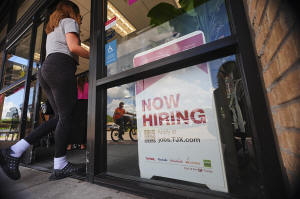Trump says he doesn't trust the jobs data, but Wall Street and
economists do
[August 05, 2025] By
CHRISTOPHER RUGABER
WASHINGTON (AP) — The monthly jobs report is already closely-watched on
Wall Street and in Washington but has taken on a new importance after
President Donald Trump on Friday fired the official who oversees it.
Trump claimed that June's employment figures were “RIGGED” to make him
and other Republicans “look bad.” Yet he provided no evidence and even
the official Trump had appointed in his first term to oversee the
report, William Beach, condemned the firing of Erika McEntarfer, the
director of the Bureau of Labor Statistics appointed by former President
Joe Biden. The firing followed Friday's jobs report that showed hiring
was weak in July and had come to nearly a standstill in May and June,
right after Trump rolled out sweeping tariffs.
Economists and Wall Street investors have long considered the job
figures reliable, with share prices and bond yields often reacting
sharply when they are released. Yet Friday’s revisions were unusually
large — the largest, outside of a recession, in five decades. And the
surveys used to compile the report are facing challenges from declining
response rates, particularly since COVID, as fewer companies complete
the surveys.
Nonetheless, that hasn't led most economists to doubt them.
“The bottom line for me is, I wouldn’t take the low collection rate as
any evidence that the numbers are less reliable,” Omair Sharif, founder
and chief economist at Inflation Insights, a consulting firm, said.
Many academics, statisticians and economists have warned for some time
that declining budgets were straining the government's ability to gather
economic data. There were several government commissions studying ways
to improve things like survey response rates, but the Trump
administration disbanded them earlier this year.

Heather Boushey, a top economic adviser in the Biden White House, noted
that without Trump's firing of McEntarfer, there would be more focus on
last week's data, which points to a slowing economy.
“We’re having this conversation about made-up issues to distract us from
what the data is showing," Boushey said. “Revisions of this magnitude in
a negative direction may indicate bad things to come for the labor
market.”
Here are some things to know about the jobs report:
Economists and Wall Street trust the data
Most economists say that the Bureau of Labor Statistics is a
nonpolitical agency staffed by people obsessed with getting the numbers
right. The only political appointee is the commissioner, who doesn't see
the data until it's finalized, two days before it is issued to the
public.
Erica Groshen, the BLS commissioner from 2013 to 2017, said she
suggested different language in the report to "liven it up", but was
shot down. She was told that if asked to describe a cup as half-empty or
half-full, BLS says “it is an eight ounce cup with four ounces of
liquid.”
The revised jobs data that has attracted Trump's ire is actually more in
line with other figures than before the revision. For example, payroll
processor ADP uses data from its millions of clients to calculate its
own jobs report, and it showed a sharp hiring slowdown in May and June
that is closer to the revised BLS data.
Trump and his White House have a long track record of celebrating the
jobs numbers — when they are good.
These are the figures Trump is attacking
Trump has focused on the revisions to the May and June data, which on
Friday were revised lower, with job gains in May reduced to 19,000 from
144,000, and for June to just 14,000 from 147,000. Every month's jobs
data is revised in the following two months.
Trump also repeated a largely inaccurate attack from the campaign about
an annual revision last August, which reduced total employment in the
United States by 818,000, or about 0.5%. The government also revises
employment figures every year.

Trump charged the annual revision was released before the 2024
presidential election to “boost” Vice President Kamala Harris's "chances
of Victory," yet it was two months before the election and widely
reported at the time that the revision lowered hiring during the
Biden-Harris administration and pointed to a weaker economy.
Here's why the government revises the data
The monthly revisions occur because many companies that respond to the
government's surveys send their data in late, or correct the figures
they've already submitted. The proportion of companies sending in their
data later has risen in the past decade.
Every year, the BLS does an additional revision based on actual job
counts that are derived from state unemployment insurance records. Those
figures cover 95% of U.S. businesses and aren't derived from a survey
but are not available in real time.
[to top of second column] |

A sign announces hiring, July 15, 2025, in Richardson, Texas. (AP
Photo/LM Otero, File)
 These are the factors that cause
revisions
Figuring out how many new jobs have been added or lost each month is
more complicated than it may sound. For example, if one person takes
a second job, should you focus on the number of jobs, which has
increased, or the number of employed people, which hasn't? (The
government measures both: The unemployment rate is based on how many
people either have or don't have jobs, while the number of jobs
added or lost is counted separately).
Each month, the government surveys about 121,000 businesses and
government agencies at over 630,000 locations — including multiple
locations for the same business — covering about one-third of all
workers.
Still, the government also has to make estimates: What if a company
goes out of business? It likely won't fill out any forms showing the
jobs lost. And what about new businesses? They can take a while to
get on the government's radar.
The BLS seeks to capture these trends by estimating their impact on
employment. Those estimates can be wrong, of course, until they are
fixed by the annual revisions.
The revisions are often larger around turning points in the economy.
For example, when the economy is growing, there may be more startups
than the government expects, so revisions will be higher. If the
economy is slowing or slipping into a recession, the revisions may
be larger on the downside.
Here's why the May and June revisions may have been so large
Ernie Tedeschi, an economic adviser to the Biden administration,
points to the current dynamics of the labor market: Both hiring and
firing have sharply declined, and fewer Americans are quitting their
jobs to take other work. As a result, most of the job gains or
losses each month are probably occurring at new companies, or those
going out of business.
And those are the ones the government uses models to estimate, which
can make them more volatile.
Groshen also points out that since the pandemic there has been a
surge of new start-up companies, after many Americans lost their
jobs or sought more independence. Yet they may not have created as
many jobs as startups did pre-COVID, which throws off the
government’s models.

Revisions seem to be getting bigger
The revisions to May and June's job totals, which reduced hiring by
a total of 258,000, were the largest — outside recessions — since
1967, according to economists at Goldman Sachs.
Kevin Hassett, Trump's top economic adviser, went on NBC's “Meet the
Press” on Sunday and said, “What we’ve seen over the last few years
is massive revisions to the jobs numbers.”
Hassett blamed a sharp drop in response rates to the government's
surveys during and after the pandemic: “When COVID happened, because
response rates went down a lot, then revision rates skyrocketed.”
Yet calculations by Tedeschi show that while revisions spiked after
the pandemic, they have since declined and are much smaller than in
the 1960s and 1970s.
Other concerns about the government's data
Many economists and statisticians have sounded the alarm about
things like declining response rates for years. A decade ago, about
60% of companies surveyed by BLS responded. Now, only about 40% do.
The decline has been an international phenomenon, particularly since
COVID. The United Kingdom has even suspended publication of an
official unemployment rate because of falling responses.
And earlier this year the BLS said that it was cutting back on its
collection of inflation data because of the Trump administration's
hiring freeze, raising concerns about the robustness of price data
just as economists are trying to gauge the impact of tariffs on
inflation.
U.S. government statistical agencies have seen an inflation-adjusted
16% drop in funding since 2009, according to a July report from the
American Statistical Association.
“We are at an inflection point,” the report said. “To meet current
and future challenges requires thoughtful, well-planned investment
... In contrast, what we have observed is uncoordinated and
unplanned reductions with no visible plan for the future.
All contents © copyright 2025 Associated Press. All rights reserved |